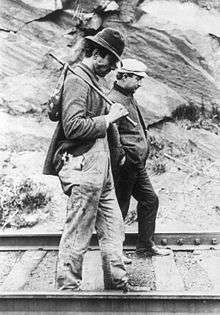Bindle
A bindle is the bag, sack, or carrying device stereotypically used by the American sub-culture of hobos. A "bindlestiff" was another name for a hobo who carried a bindle. The bindle is colloquially known as the "blanket stick", particularly within the Northeastern hobo community. A "bindlestiff", according to James Blish in his novel, A Life for the Stars, was about a hobo who stole another hobo's "bindle," hence the colloquium "stiff" as in steal.

In modern popular culture the bindle is portrayed as a stick with cloth or a blanket tied around one end for carrying items, with the entire array being carried over the shoulder. This transferred force to the shoulder, which allowed a longer-lasting and comfortable grip, especially with larger heavier loads. Particularly in cartoons, the bindles' sacks usually have a polka-dot or bandanna design. However, in actual use the bindle can take many forms.
One example of the stick-type bindle can be seen in the illustration entitled The Runaway created by Norman Rockwell for the cover of the September 20, 1958, edition of The Saturday Evening Post.[1]
Though bindles are rarely used anymore, they are still widely seen in popular culture as a prevalent anachronism.
The term bindle may descend from the German word Bündel, meaning something wrapped up in a blanket and bound by cord for carrying (cf. originally Middle Dutch bundle), or have arisen as a portmanteau of "bind" and "spindle".[2]
More recently, the term has come to be used to define packages of illegal drugs, particularly heroin, in which it typically refers to ten single 'bags' bound together with a rubber band, although this is more commonly called a bundle.[3]
See also
References
- "Norman Rockwell: The Runaway". Artchive.com. 1958-09-20. Retrieved 2011-10-24.
- "Definition of BINDLE".
- Wissbaum, Brandon. "Police arrest known drug dealer, seize 800 bindles of heroin".